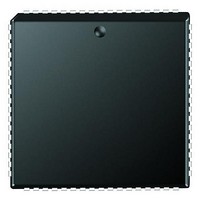PIC18F6680-I/L Microchip Technology, PIC18F6680-I/L Datasheet - Page 220

PIC18F6680-I/L
Manufacturer Part Number
PIC18F6680-I/L
Description
Microcontrollers (MCU) 64KB 3328 RAM 52 I/O
Manufacturer
Microchip Technology
Datasheet
1.PCM18XK1.pdf
(496 pages)
Specifications of PIC18F6680-I/L
Processor Series
PIC18F
Core
PIC
Data Bus Width
8 bit
Data Ram Size
3.25 KB
Interface Type
I2C/SPI/AUSART/CAN
Maximum Clock Frequency
40 MHz
Number Of Programmable I/os
53
Number Of Timers
5
Operating Supply Voltage
4.2 V to 5.5 V
Maximum Operating Temperature
+ 85 C
Mounting Style
SMD/SMT
3rd Party Development Tools
52715-96, 52716-328, 52717-734, 52712-325, EWPIC18
Development Tools By Supplier
PG164130, DV164035, DV244005, DV164005, PG164120, ICE2000, ICE4000, DV164136
Minimum Operating Temperature
- 40 C
On-chip Adc
12-ch x 10-bit
Program Memory Type
Flash
Program Memory Size
64 KB
Package / Case
PLCC-68
Lead Free Status / RoHS Status
Lead free / RoHS Compliant
Available stocks
Company
Part Number
Manufacturer
Quantity
Price
Company:
Part Number:
PIC18F6680-I/L
Manufacturer:
RUBYCON
Quantity:
46 000
Part Number:
PIC18F6680-I/L
Manufacturer:
MICROCH
Quantity:
20 000
- Current page: 220 of 496
- Download datasheet (9Mb)
PIC18F6585/8585/6680/8680
17.4.9
A Repeated Start condition occurs when the RSEN bit
(SSPCON2<1>) is programmed high and the I
module is in the Idle state. When the RSEN bit is set,
the SCL pin is asserted low. When the SCL pin is
sampled low, the Baud Rate Generator is loaded with
the contents of SSPADD<5:0> and begins counting.
The SDA pin is released (brought high) for one Baud
Rate Generator count (T
Generator times out, if SDA is sampled high, the SCL
pin will be deasserted (brought high). When SCL is
sampled high, the Baud Rate Generator is reloaded
with the contents of SSPADD<6:0> and begins count-
ing. SDA and SCL must be sampled high for one T
This action is then followed by assertion of the SDA pin
(SDA = 0) for one T
this, the RSEN bit (SSPCON2<1>) will be automatically
cleared and the Baud Rate Generator will not be
reloaded, leaving the SDA pin held low. As soon as a
Start condition is detected on the SDA and SCL pins,
the S bit (SSPSTAT<3>) will be set. The SSPIF bit will
not be set until the Baud Rate Generator has timed out.
FIGURE 17-20:
DS30491C-page 218
Note 1: If RSEN is programmed while any other
2: A bus collision during the Repeated Start
I
START CONDITION TIMING
• SDA is sampled low when SCL goes
• SCL goes low before SDA is
2
event is in progress, it will not take effect.
condition occurs if:
C MASTER MODE REPEATED
from low-to-high.
asserted low. This may indicate that
another master is attempting to
transmit a data ‘1’.
Falling edge of ninth clock,
BRG
REPEAT START CONDITION WAVEFORM
SDA
SCL
while SCL is high. Following
BRG
). When the Baud Rate
end of Xmit
Write to SSPCON2
occurs here.
SDA = 1,
SCL (no change).
2
C logic
BRG
T
SDA = 1,
SCL = 1
.
BRG
T
BRG
Immediately following the SSPIF bit getting set, the
user may write the SSPBUF with the 7-bit address in
7-bit mode, or the default first address in 10-bit mode.
After the first eight bits are transmitted and an ACK is
received, the user may then transmit an additional eight
bits of address (10-bit mode) or eight bits of data (7-bit
mode).
17.4.9.1
If the user writes the SSPBUF when a Repeated Start
sequence is in progress, the WCOL is set and the con-
tents of the buffer are unchanged (the write doesn’t
occur).
Note:
Sr = Repeated Start
T
BRG
At completion of Start bit,
hardware clears RSEN bit
Set S (SSPSTAT<3>)
and sets SSPIF
Because queueing of events is not
allowed, writing of the lower 5 bits of
SSPCON2 is disabled until the Repeated
Start condition is complete.
Write to SSPBUF occurs here
WCOL Status Flag
T
BRG
1st bit
T
BRG
2004 Microchip Technology Inc.
Related parts for PIC18F6680-I/L
Image
Part Number
Description
Manufacturer
Datasheet
Request
R

Part Number:
Description:
20-Pin USB Flash Microcontrollers
Manufacturer:
MICROCHIP [Microchip Technology]
Datasheet:

Part Number:
Description:
PIC18F With 128-segment LCD Driver And 12-bit ADC, 8KB Flash, 768B RAM, CCP, MSS
Manufacturer:
Microchip Technology
Datasheet:

Part Number:
Description:
PIC18F With 128-segment LCD Driver And 12-bit ADC, 16KB Flash, 768B RAM, CCP, MS
Manufacturer:
Microchip Technology
Datasheet:

Part Number:
Description:
PIC18F With 192-segment LCD Driver And 12-bit ADC, 8KB Flash, 768B RAM, CCP, MSS
Manufacturer:
Microchip Technology
Datasheet:

Part Number:
Description:
PIC18F With 192-segment LCD Driver And 12-bit ADC, 16KB Flash, 768B RAM, CCP, MS
Manufacturer:
Microchip Technology
Datasheet:

Part Number:
Description:
Microcontrollers (MCU) 48KB 3328 RAM 52 I/O
Manufacturer:
Microchip Technology
Datasheet:

Part Number:
Description:
32kB Flash, 2kB RAM, 1kB EE, NanoWatt XLP, LCD 64 QFN 9x9x0.9mm T/R
Manufacturer:
Microchip Technology
Datasheet:

Part Number:
Description:
32kB Flash, 2kB RAM, 1kB EE, NanoWatt XLP, LCD 64 TQFP 10x10x1mm T/R
Manufacturer:
Microchip Technology
Datasheet:

Part Number:
Description:
128kB Flash, 4kB RAM, 1kB EE, 16MIPS, NanoWatt XLP, LCD, 5V 80 TQFP 12x12x1mm T/
Manufacturer:
Microchip Technology
Datasheet:

Part Number:
Description:
32kB Flash, 2kB RAM, 1kB EE, NanoWatt XLP, LCD 64 QFN 9x9x0.9mm TUBE
Manufacturer:
Microchip Technology
Datasheet:

Part Number:
Description:
32kB Flash, 2kB RAM, 1kB EE, NanoWatt XLP, LCD 64 TQFP 10x10x1mm TRAY
Manufacturer:
Microchip Technology

Part Number:
Description:
128kB Flash, 4kB RAM, 1kB EE, 16MIPS, NanoWatt XLP, LCD, 5V 80 TQFP 12x12x1mm TR
Manufacturer:
Microchip Technology

Part Number:
Description:
Manufacturer:
Microchip Technology Inc.
Datasheet:











